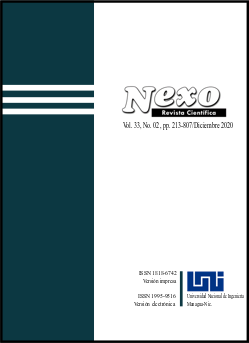Sedimentary and textural parameters continuity and mineralogical characteristics of the Jajrood river, Iran
DOI:
https://doi.org/10.5377/nexo.v33i02.10766Keywords:
Jajrood river, Latiyan dam, Sediment, Cumulative curveAbstract
In this research, we try to study the sedimentary characteristics and the trend of textural changes in the sediments of the Jajrood River from upstream to downstream at the point of junction to Latiyan dam. Based on the textural changes of sediments along the path from the upstream in the Garmabdar area to the downstream to the Latiyan Dam, the Jajrood River is divided into four A, B, C and D basins. Twenty sediment samples were collected and all sieved by dry and wet method also the specimens were morphoscopically studied. Data from field and laboratory phases were combined and interpreted using reliable scientific sources and finally a detailed summary was obtained regarding sedimentology of the study area. Mineralogically, the sediment type of the river is a clastic carbonate sedimentary type with fragments ranging from 30 to 58 percent and rock fragments between 25 to 50 percent abundance. Other minerals, such as feldspar minerals, account for about 1 to 4 percent, quartz 5 to 10 percent, and opauqe minerals from 1 to 5 percent. Examination of the average particle size in the A to D basins shows that decreasing trend of sediment size from the A to C basin occurs and reverses in the D basin. In the first three basins, the sorting grade of the river sediments is very bad and in the last basin it has become extremely bad. The amount of kurtosis of the particle distribution curve from upstream to downstream of the river is generally increasing trend. Textural changes along the river do not follow natural conditions due to the influence of various natural factors such as the entry of distributary into the main River, and phenomena such as landslide and rock collapses and debris flows, especially during floods along the riverbank.
Downloads
Downloads
Published
How to Cite
Issue
Section
License
Copyright (c) 2021 Array

This work is licensed under a Creative Commons Attribution 4.0 International License.
The authors who publish in Nexo Scientific Journal agree to the following terms:
- Authors retain the copyright and grant the journal the right of the first publication under the license Creative Commons Attribution License https://creativecommons.org/licenses/by/3.0/, which allows others to share the work with a recognition of the authorship of the work and the initial publication in Nexo Scientific Journal.
- Authors may separately establish additional agreements for the non-exclusive distribution of the version of the work published in the journal (for example, in an institutional repository or a book), with the recognition of the initial publication in Nexo Scientific Journal.
- Authors are allowed and encouraged to disseminate their works electronically (for example, in institutional repositories or in their own website) before and during the submission process, as it can lead to productive exchanges, as well as earlier and greater citation of published works.











